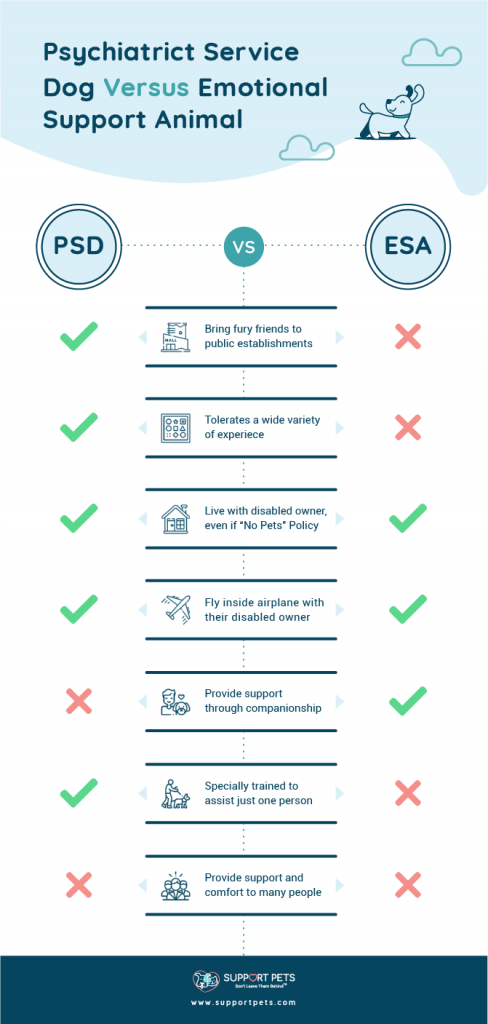We all know what pets are. They’re part of the family and bring us unconditional love and joy every day! Technically, pets are “animals that are kept for company or entertainment rather than being working animals, laboratory animals or livestock.” That dry definition doesn’t come close to describing the wealth of benefits we get from having pets in our lives!
But it’s important to know exactly what defines a pet and separates it from both Emotional Support Animals (ESA) and Psychiatric Service Dogs (PSD), as well as what separates those two categories from each other.
What is an Official ESA®?
Emotional support animals are a gift to people suffering from a range of disorders. They provide support and can calm people in the middle of a panic attack, suffering from depression or managing post-traumatic stress disorder (PTSD). ESAs don’t require special training or perform special tasks. For someone to have an ESA, a doctor must prescribe that to them based on a diagnosed mental or emotional condition that requires additional emotional support.
Although ESAs are protected from pet restrictions and fees by the Federal Housing Act, private businesses can choose whether or not to allow ESAs on the premises. Most businesses accept well-behaved Emotional Support Animals, including public transportation, ride shares, shops and restaurants. More employers than ever are open to the presence of well-behaved ESAs in the office as well, if conditions are safe for both employees and the ESA.
Although the majority of ESAs are dogs, with cats second, they can be anything: rabbits, hedgehogs, even birds, and more!
What is a Psychiatric Service Dog?
The Americans with Disabilities Act (ADA) carefully defines service animals. Service animals must be trained to perform specific tasks and perform services to their owners. Seeing-eye dogs for the visually impaired are probably the type of service dog that most people are familiar with. But service animals can perform a variety of tasks for people with a range of conditions, including deafness, mobility issues, multiple sclerosis, cancer and epilepsy. That includes mental and emotional illnesses as well, which is where Psychiatric Support Dogs (PSDs) come in.
Many of the same conditions that emotional support animals can help their owners with can be helped by psychiatric service dogs as well. Those include depression, anxiety, PTSD, learning disabilities, attention deficit/hyperactivity disorders (ADHD), phobias, anxiety, depression, bi-polar disorder, autism and obsessive compulsive disorder.

Why do we say Psychiatric Service DOG? The ADA is strict that service animals, unlike ESAs, must be dogs, and in very specific circumstances, horses. So to simplify, we talk about Psychiatric Service Dogs rather than Psychiatric Service Animals.
Just like any other service dog, PSDs must perform specific tasks for their owners and be trained to do so. Those tasks may include:
- Retrieving medications
- Reacting and alerting the owner to specific sounds like fire alarms
- Grounding and reorienting people having an anxiety or panic attack
- Assisting with balance for people who are unsteady walking due to medications or other issues
- Locating people or places in a crowd
- Interrupting and redirecting people exhibiting OCD or self-destructive behaviors
- Navigating a person through a stressful environment such as a crowd and buffering them from people in that crowd
- Searching the room for people with PTSD
- Maintaining healthy routines through task reminders
- Performing tactile stimulation and pressure therapy when their owner is in distress
It’s important for owners of PSDs to understand that no one is allowed to ask your PSD to demonstrate the tasks that it is trained to perform. They may ask IF you have a condition that requires the assistance of a PSD, but not what that condition is nor how severe it is. That’s part of your right to privacy under the ADA.
Like all service animals, PSDs have the same rights to be in any place that serves the public. While businesses may elect not to all ESAs inside, they must allow PSDs in. That includes all housing and lodging, including apartments and hotels; public transit and airplanes; and all public spaces including offices, university campuses, restaurants, bars, stores, supermarkets and more.
What’s the difference between a PSD and an ESA?
The difference in the two types of animals is primarily about the tasks they are trained to perform and the type of animal. No bird or rabbit, no matter how supportive they are to a person in need, can be a PSD, but they can be ESAs. At the same time, if a dog is not trained to perform a specific task, it cannot be a PSD, but it can still qualify as an ESA. The difference rests in the type of animal and its training.
How Do I Know If I Need an ESA or a PSD?
It’s important to understand that the difference between an ESA and a PSD does not depend on the severity of a mental or emotional condition. The best way to find out if you need a PSD is to work with a licensed doctor who will ask you to describe your symptoms and assess your situation to determine the need for a PSD or an ESA. If a doctor concludes that you can benefit from a psychiatric support dog, that’s the way to go.
Can My Pet Become an ESA or a PSD?





